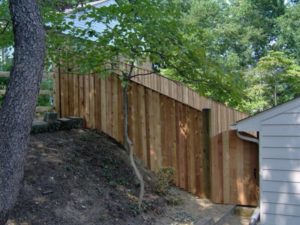
Hercules Fence DC offers durable cedarwood to help your fence avoid rot.
A wood fence can be a charming addition to any yard. However, maintaining a wood fence takes some care and attention. In particular, homeowners will want to watch for wood rot on their fence as that wood fence is exposed to the elements. A rotting fence not only impairs the beauty of a fence but its strength as well. It is important to know what causes rot, so you know when your fence is at risk. Then, you can follow our suggestions below for addressing and avoiding future rot on your wood fence.
What Causes Dry Rot
When a wooden fence loses the natural oils on its surface, dry rot can occur. This loss of oil comes with continual exposure to sun and wind. As these protective oils disappear, wooden fences can become brittle and break. Dry rot is a particular problem in harsh, dry climates.
What Causes Wet Rot
In environments that experience a variety of weather, wet rot can occur when the fence is in contact with moisture from rainfall, snow, or even lawn sprinklers. When a wooden fence suffers from wet rot, it can become cracked and soft, it may grow fungus, and a damp smell may develop.
Use Quality Materials to Avoid Rot
When you are installing your fence, be sure to choose quality fence materials resistant to decay. Hardwoods such as cedar, cypress, oak, or redwood are good choices. Softer woods include Douglas fir, tamarack, and pine and provide less long-term decay prevention. A popular residential fencing choice at Hercules Fence DC is cedar.
Hercules Fence also offers ACQ lumber, a pressure-treated wood that has a protective barrier against insects and decay.
Hire a Professional to Install Your Fence
A DIY fence may sound like a money-saving option, but it can cost you more in the long run if you do not install the fence properly. Hiring a professional who knows how to keep the posts out of contact with soil will help prevent the fence from rotting.
Stain Your Wood Fence
Because wooden fences are made of organic materials, it naturally absorbs moisture like a sponge. When you apply wood stain to your fence, the porous texture of the wood is sealed, which reduces the absorption of moisture into the wood.
The stain should be re-applied every one to three years. You can test your wood by sprinkling water on the fence and seeing whether it beads up. If the water doesn’t bead up, that means the wood has absorbed it, and the stain should be re-applied.
Keep the Wood Fence Clean
Maintaining the cleanliness of your wood fence is key to preventing rot, as well as maintaining an attractive fence. Rake away leaves from the base of the fence, and trim back any hanging or overgrown vegetation. Clean off any fungus, and inspect the fence for insect infestations. If you notice an infestation, the pests should be removed or treated immediately. Insects such as termites and carpenter ants will eat or burrow through the wood, which weakens its structure.
You can clean your fence with a pressure washer on low, or with a hose and a bleach and water solution. Cleaning your fence affords you the chance to inspect the wood for rot. You should clean your fence at least once a year, or sooner if needed.
Replace Any Rotted Wood
If you notice any wood rot, you should replace the posts or boards as soon as possible. Leaving the rotted wood creates a weak spot on your fence. If the rot comes from a fungus, that fungus may spread if you do not quickly remove the affected areas.
Residential Fences for Your Home from Hercules Fence DC
Hercules Fence DC has been providing homeowners with quality fences for over 50 years. We are well equipped to meet your needs, whether they are residential or commercial. We have extensive experience working with families and pet owners to keep the most important members of their home safe, so call us today about installing a new pet fence for your family. Contact us by giving us a call at 301-441-1600 or visiting us online. To see examples of our work, follow us on Facebook, Twitter, LinkedIn, Pinterest, and Flickr.








